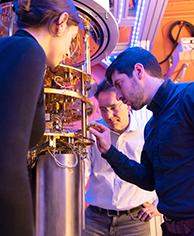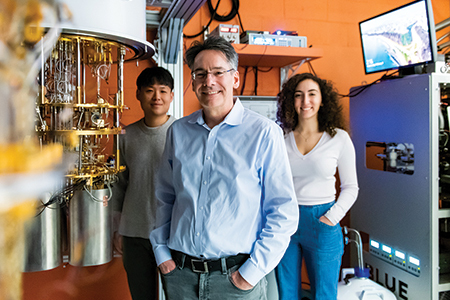Leaping at a Quantum Opportunity
An IRA gift makes new research paths possible

William Oliver, the Henry Ellis Warren Professor of electrical engineering and director of MIT’s Center for Quantum Engineering, is working toward building reliable, compact quantum computers. Now, a Faculty Research Innovation Fund grant, supported by Professor Emeritus Richard Thornton SM ’54, ScD ’57 using funds from his IRA, has made it possible for Oliver to pursue a new research path.
The promise of quantum computing.
Research that leads to world-changing discoveries often depends on computer-generated simulations of complex, variable systems that are currently impossible to produce without making approximations. But what if researchers could fully generate accurate, transferrable results without the guesswork?

candidates Hanlim "Harry" Kang (left) and Aziza Almanakly SM '22.
“The promise of quantum computing is that it will help us understand the world around us with more accurate simulations so that we can develop new materials or quantum chemistry, and that the technologies resulting from those advances will lead to solutions to some of the really thorny problems we’re facing,” says Oliver. “We’re moving closer to quantum computing becoming a technical reality, and we’re only just beginning to imagine its potential applications.”
The power to pivot.
For the past 20 years as an investigator at MIT Lincoln Laboratory and as an MIT professor since 2019, Oliver has been working with a quantum computing logic device called a superconducting qubit, which he and his team are presently using to build quantum computers that each fill up most of a room. Yet he sees the potential benefits of a different approach: the semiconducting qubit, which could be a better candidate for commercializing more compact quantum computers in the long term.
Oliver’s new work on semiconductors gained significant momentum in 2021 when he was awarded a Faculty Research Innovation Fund (FRIF) grant that encourages mid-career professors to place necessary bets on novel ideas and explore exciting, untested directions. “We couldn’t have gotten the effort off the ground without the discretionary support from the FRIF,” Oliver says. “Since then, we’ve been able to secure additional funding, purchase large pieces of infrastructure, and begin outfitting a new lab space.”
Risk and reward.
“My hope is that MIT will remain at the forefront of leading the way to a better future.”
The Thornton Family Faculty Research Innovation Fund was established in 2018 by Richard Thornton using funds from his IRA. As a former electrical engineering professor who also founded two companies, he understands the importance of academic freedom. “Over my career, I observed that virtually all MIT faculty at some point had to make significant changes in their career,” he says, recalling how his own research moved from electronic circuits to linear motors and magnetic levitation. “It can be difficult for a faculty member to pivot because, ironically, if you’re an expert in the field, it’s easier to gain funding to be a better expert in that field. It’s much harder to transition.”

with a dilution refrigerator.
More than 30 MIT School of Engineering faculty have benefitted from FRIFs like Thornton’s. For him, inventiveness is key to the future of MIT and the technologies developed here. “It is important that professors have room to be creative,” he says. “My hope is that MIT will remain at the forefront of leading the way to a better future.”
Oliver certainly sees that possibility with quantum computing. “Quantum computers are not going to print out a solution to problems like climate change,” he says, “but they may facilitate faster development of a material—for example, a better battery—that helps us solve climate change. It’s one tool we can use to solve the world’s problems.”
